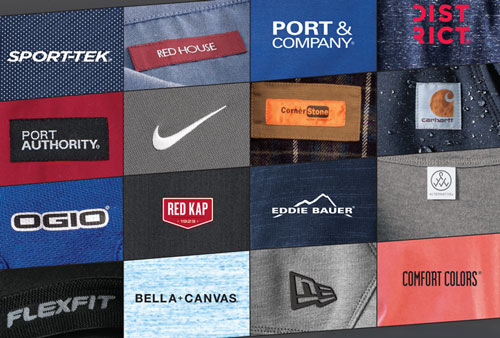Branded Clothing Maintenance Tips Based on Fabric Composition
Branded Clothing Maintenance Tips Based on Fabric Composition
Blog Article
Recognizing Apparel: The Value of Fabric Options in Your Closet
The selection of material in clothing plays a crucial role in both appearances and capability. Various products use varying levels of breathability, comfort, and toughness, directly influencing the user's experience. Comprehending these subtleties can improve one's closet significantly. Many forget exactly how these choices can affect not just personal style, yet additionally sustainability. What textile decisions could redefine your wardrobe and straighten it with both style and duty?
The Duty of Fabric in Style and Functionality

Common Material Kinds and Their Characteristics
When selecting garments, comprehending the characteristics of typical textile types is vital for making informed selections. Cotton, a widely-used natural fiber, is known for its breathability, adaptability, and gentleness, making it ideal for casual wear and everyday garments. Linen, one more all-natural alternative, boasts superb moisture-wicking buildings and an unique appearance, suitable for cozy climates.Wool, often favored for its heat and longevity, varies in excellence; merino woollen is soft against the skin, while coarser kinds are utilized for outerwear. Synthetic textiles like polyester and nylon offer resilience and resistance to creases, making them prominent for activewear and traveling garments. Blends, which integrate artificial and all-natural fibers, can enhance capability while maintaining comfort. By identifying these fabric characteristics, individuals can select garments that straightens with their lifestyle and visual preferences.
Breathability and Comfort: Picking the Right Fabrics for Various Climates
Picking the best fabrics for different environments can greatly improve convenience and overall wearability. Breathable products are crucial in warm environments, as they allow air circulation and moisture dissipation. Fabrics such as cotton, linen, and moisture-wicking synthetics efficiently attract sweat far from the body, maintaining the wearer cool and completely dry. Alternatively, in colder environments, thicker textiles like wool or fleece give insulation while retaining breathability, guaranteeing heat without overheating.Additionally, the choice of textile weight plays a crucial role; lightweight fabrics are more suitable for summer, whereas much heavier alternatives are suited for winter months wear. Comprehending the one-of-a-kind residential or commercial properties of each material allows individuals to dress suitably for varying climate condition. Inevitably, picking comfortable and breathable materials tailored to certain environments can significantly boost daily comfort and improve the general experience of putting on clothes.
Resilience and Care: Just How Material Affects Longevity of Your Wardrobe
Selecting the ideal materials can greatly impact the durability and care demands of a wardrobe. Fabrics such as cotton and polyester are understood for their strength and ease of upkeep, making them optimal for day-to-day wear. On the other hand, delicate materials like silk and lace call for more careful handling and specialized cleansing methods, which can raise the moment and effort needed for care. Branded Clothing.Durability is likewise influenced by the fabric's weave and finish; securely woven materials tend to stand up to wear and tear better than freely woven alternatives. Additionally, synthetic blends commonly provide improved toughness, incorporating the ideal qualities of numerous fibers.Understanding the treatment guidelines for every material is necessary, as incorrect cleaning or drying can lead to premature wear. Inevitably, selecting resilient products can cause a longer-lasting wardrobe, minimizing the frequency of substitutes and adding to a more sustainable style choice
The Influence of Fabric on Fit and Silhouette

Sustainable Material Selections: Making Eco-Friendly Choices
The impact of fabric expands beyond fit and silhouette to encompass environmental variables, triggering a growing rate of interest in lasting textile choices. Green fabrics, such as natural cotton, hemp, and Tencel, are gaining grip amongst customers that focus on sustainability in their wardrobes. These products are often generated with less chemicals and water, reducing their environmental footprint.Additionally, recycled fabrics, made from post-consumer waste, provide an ingenious solution to the fabric industry's air pollution issue. Brands significantly embrace transparency in their sourcing methods, permitting consumers to make enlightened decisions regarding their purchases.Choosing sustainable fabrics not just sustains ethical practices yet additionally urges the style market to take on more accountable manufacturing techniques. As understanding of ecological issues climbs, individuals are prompted to mirror on the lasting effect of their fabric selections, promoting a movement in the direction of a much more ecologically aware and lasting strategy to fashion.
Elevating Design: Exactly How Fabric Can Transform an Attire
While many may concentrate on shade and cut when choosing a clothing, the option of textile plays an essential function in elevating design and enhancing overall appearance. Different materials convey distinct state of minds and messages; for instance, silk emanates luxury and sophistication, while denim provides a laid-back, kicked back ambiance. The click over here texture and drape of a material can significantly change the shape, with organized textiles offering a sleek appearance and softer ones producing an extra fluid, relaxed aesthetic.Moreover, the weight of the fabric influences wearability throughout seasons. Light-weight textiles like linen and cotton are excellent for summer season, while much heavier materials such as wool and velvet give heat and elegance in colder months. Understanding textile properties, such as breathability and stretch, likewise equips individuals to make informed selections that improve convenience without endangering style. Inevitably, the appropriate material can transform an attire from ordinary to extraordinary, making it a vital factor to consider in any kind of closet.
Often Asked Inquiries
How Do I Identify the Material Web Content of My Apparel?
To determine fabric web content, one can take a look at treatment tags, conduct burn examinations for fiber recognition, or consult textile examples. These techniques aid separate materials, ensuring notified selections for garments treatment and upkeep in everyday wear.
Can Fabric Choice Affect My State Of Mind or Self-confidence?
Textile option can significantly affect a person's mood and self-confidence. Branded Clothing. Certain materials might evoke sensations of convenience or beauty, while others can really feel restrictive or uncomplimentary, inevitably affecting self-perception and psychological health throughout the day
What Fabrics Are Finest for Sensitive Skin?
For people with sensitive skin, all-natural materials like bed linen, cotton, and bamboo are typically recommended. These products are breathable, hypoallergenic, and much less likely to create inflammation, making them ideal selections for comfort and skin health and wellness.
Just how Do I Correctly Wash and Take Care Of Different Fabrics?
To appropriately clean and care for different materials, one need to take into consideration each material's details requirements, including temperature setups, detergents, and drying techniques, ensuring durability and preserving the material's initial high qualities for excellent use.
Are There Specific Fabrics for Athletic or Efficiency Put On?
Sports or performance wear frequently makes use of fabrics such as nylon, polyester, and spandex. These products are developed for moisture-wicking, breathability, and versatility, improving motion and see this page comfort throughout physical tasks while giving toughness and assistance. Alternatively, in cooler environments, thicker textiles like woollen or fleece offer insulation while keeping breathability, making sure warmth without overheating.Additionally, the option of textile weight plays a vital duty; light-weight fabrics are better for summer, whereas heavier options are matched for winter months wear. In comparison, delicate materials like silk and lace call for even more cautious handling and specialized cleaning approaches, which can increase the time and effort needed for care.Durability is additionally affected by the textile's weave and coating; securely woven materials have a tendency to withstand wear and tear better than freely woven choices. In comparison, inflexible fabrics can restrict activity but supply a classic, refined look.Moreover, the density and texture of the textile can influence the aesthetic assumption of body shape. The impact of fabric expands beyond fit and silhouette to incorporate environmental factors, triggering a growing passion in sustainable fabric selections. The structure and drape of a you can try here textile can significantly alter the silhouette, with structured materials providing a refined look and softer ones creating a much more fluid, kicked back aesthetic.Moreover, the weight of the fabric influences wearability throughout periods.
Report this page